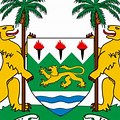The advent of 3D printing, like other Fourth Industrial Revolution technologies, has broad and unexpected uses. This groundbreaking machinery creates objects layer by layer, and can make intricate patterns and structures previously impossible to manufacture. Globally, 3D printing, coupled with automation, has already affected how 21st-century manufacturing takes place across many industries from aviation to agriculture. In the medical domain, it has been used by practitioners to improve lives through 3D printed prosthetics and surgical aids. Artisans, hobbyists and fashion makers have launched entrepreneurial businesses selling 3D printed products. International organizations have supported the use of 3D printing-based rapid prototyping in sectors such as agriculture, education and broader international development. But some other surprising uses are starting to show up.
Recently, President Julius Maada Bio used a 3D printer to create a map of Sierra Leone, illustrating the distribution of the number of girls not attending primary school across the country. The idea evolved over lunch at State House, where senior government officials were discussing the status of education within the country. The president wondered about ways in which existing complex data could be made more interpretable, so that anyone could understand the challenges facing the education sector. It was difficult for other people to fully participate in the discussions because there were no screens at the table. The Directorate of Science, Technology and Innovation (DSTI), located in State House, engaged immediately to calculate the distribution of out-of-school girls in each chiefdom and generated an accurate representation of the analyses in a 3D model.
President Bio 3D-printed the model for use in a policy discussion with the head of the UK’s Department for International Development, Mary Hunt. “The fact you can pick it up and turn it around to see different aspects of the map makes you feel like you are there – in Kenema, Kabala or Bonthe – seeing the challenges in people’s lives and what needs to change,” said Hunt. “I was so drawn to its clarity and potential, I had to ask the president if I could take it with me – I wanted to share it with others.”
President Bio also printed a representation of the relative distances children must walk to access schools in their chiefdoms. While every chiefdom has at least several primary schools and one junior secondary school, the locations of the schools may not be ideal for students. He used the 3D-printed model in conversations with cabinet ministers and senior government officials, to explore how recently acquired government buses should be distributed across the country. It was immediately apparent that the region with the highest peak in the model, the Gola forest area, had the biggest need, which triggered conversations about roads in that area. These models also informed further analyses by the DSTI team to explore the ideal locations of new schools to be built by government and its partners.
In Sierra Leone, these data-driven policy conversations also happen at other levels: the Ministry of Basic and Secondary School Education and education sector partners now actively use a combination of interactive dashboards of national school census data and 3D printed models in meetings.
What can we learn from Sierra Leone’s example?
As we enter an era of data explosion, visualizing data is becoming increasingly important. Further, as machine learning systems improve their ability to convert very large datasets into intuitive information, the need to present the information for decision-making and other purposes will become mainstream.
The benefits of 3D printed data are that the relative scale stands out clearly and you can touch to feel the bumps and spikes, even with eyes closed. Multiple participants can view it from different angles and have a face-to-face conversation, rather than everyone looking in the same direction at a screen. This approach cuts across language barriers and lowers bias. Finally, the “no batteries needed” aspect of turning digital data into an analogue model is powerful: you can conduct a dialog anywhere without a computer, laptop or smartphone (even over a meal).
The presentation of information in a physical 3D format is not new. What is new is combining the ability to perform complex data analytics and 3D print the results to dramatically improve the speed and quality of strategic decision-making in boardrooms and state houses around the world.
The 3D printing of data does not fully displace traditional methods of data presentation, such as on a display. Most notably, 3D printing requires time and preparation; and, when data needs to be manipulated dynamically to explore “what if” scenarios, 3D printed data alone is not an option. That said, strategic conversations at the levels of heads of organizations and states are likely to benefit the most from this novel approach.




